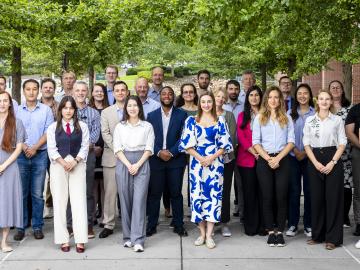
Filter News
Area of Research
- (-) Biology and Environment (179)
- (-) Fuel Cycle Science and Technology (3)
- (-) Fusion and Fission (55)
- (-) Neutron Science (191)
- Advanced Manufacturing (34)
- Biological Systems (18)
- Biology and Soft Matter (5)
- Building Technologies (12)
- Chemical and Engineering Materials (4)
- Chemistry and Physics at Interfaces (11)
- Clean Energy (525)
- Climate and Environmental Systems (14)
- Computational Biology (6)
- Computational Chemistry (5)
- Computational Engineering (5)
- Computer Science (19)
- Data (1)
- Earth Sciences (1)
- Electricity and Smart Grid (3)
- Energy Frontier Research Centers (14)
- Energy Sciences (5)
- Fossil Energy (3)
- Functional Materials for Energy (16)
- Fusion Energy (19)
- Geographic Information Science and Technology (3)
- Isotope Development and Production (3)
- Isotopes (36)
- Materials (433)
- Materials Characterization (2)
- Materials for Computing (36)
- Materials Synthesis from Atoms to Systems (13)
- Materials Under Extremes (12)
- Mathematics (1)
- National Security (81)
- Neutron Data Analysis and Visualization (4)
- Nuclear Science and Technology (74)
- Nuclear Systems Modeling, Simulation and Validation (3)
- Nuclear Systems Technology (1)
- Quantum Condensed Matter (4)
- Quantum information Science (9)
- Reactor Technology (1)
- Renewable Energy (4)
- Sensors and Controls (5)
- Supercomputing (313)
- Transportation Systems (11)
News Type
News Topics
- 3-D Printing/Advanced Manufacturing (17)
- Advanced Reactors (8)
- Artificial Intelligence (15)
- Big Data (11)
- Bioenergy (51)
- Biology (75)
- Biomedical (27)
- Biotechnology (13)
- Buildings (3)
- Chemical Sciences (17)
- Clean Water (13)
- Climate Change (42)
- Composites (6)
- Computer Science (31)
- Coronavirus (18)
- Critical Materials (2)
- Cybersecurity (1)
- Decarbonization (23)
- Education (1)
- Energy Storage (16)
- Environment (99)
- Exascale Computing (5)
- Fossil Energy (2)
- Frontier (5)
- Fusion (22)
- Grid (5)
- High-Performance Computing (23)
- Hydropower (8)
- Isotopes (3)
- ITER (6)
- Machine Learning (11)
- Materials (25)
- Materials Science (29)
- Mathematics (4)
- Mercury (7)
- Microscopy (14)
- Molten Salt (1)
- Nanotechnology (18)
- National Security (6)
- Net Zero (3)
- Neutron Science (100)
- Nuclear Energy (31)
- Partnerships (8)
- Physics (12)
- Polymers (3)
- Quantum Computing (1)
- Quantum Science (7)
- Renewable Energy (1)
- Security (4)
- Simulation (18)
- Space Exploration (3)
- Summit (15)
- Sustainable Energy (35)
- Transformational Challenge Reactor (1)
- Transportation (10)
Media Contacts
Researchers led by Oak Ridge National Laboratory have been criss-crossing the Alaskan tundra for 12 years, collecting data as part of the Next-Generation Ecosystem Experiments in the Arctic project, or NGEE Arctic. They’re tracking rapid changes in the land as temperatures rise.

Daryl Yang is coupling his science and engineering expertise to devise new ways to measure significant changes going on in the Arctic, a region that’s warming nearly four times faster than other parts of the planet. The remote sensing technologies and modeling tools he develops and leverages for the Next-Generation Ecosystem Experiments in the Arctic project, or NGEE Arctic, help improve models of the ecosystem to better inform decision-making as the landscape changes.

Three flights, five thousand miles and half a dozen clearances and permissions stood between Tetiana Maltseva and the Department of Energy’s Oak Ridge National Laboratory. When she finally arrived at the lab to represent Ukraine at the 2024 Nuclear Energy Management School, her vision was clear.

The "SNS LEGO Model Middle School Outreach Program" invites middle school students to build a LEGO model of the SNS, a major scientific accelerator. This engaging initiative aims to teach students about STEM careers and the inner workings of the SNS through hands-on construction and interactive lessons. Launching next spring, the program seeks to inspire interest in science and engineering among young learners.

Scientists at ORNL have developed 3-D-printed collimator techniques that can be used to custom design collimators that better filter out noise during different types of neutron scattering experiments

Three staff members in ORNL’s Fusion and Fission Energy and Science Directorate have moved into newly established roles facilitating communication and program management with sponsors of the directorate’s Nuclear Energy and Fuel Cycle Division.

Two fusion energy leaders have joined ORNL in the Fusion and Fission Energy and Science Directorate, or FFESD.

ORNL Environmental Sciences Division Director Eric Pierce presented the division’s 2023 Distinguished Achievement Awards at the organization’s December all-hands meeting.

For years, Duane Starr led workshops at ORNL to help others from across the U.S. government understand uranium processing technologies. After his retirement, Starr donated a 5-foot-tall working model, built in his garage, that demonstrates vibration harmonics, consistent with operation of a super critical gas centrifuge rotor, a valuable resource to ongoing ORNL-led workshops.



